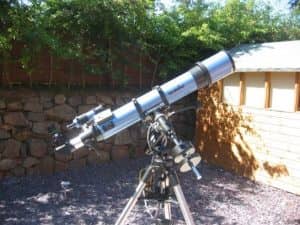How it all started
Welcome to Matt’s Astronomy Website. My name is Matthew Cook, I live in Somerset, UK. I have had an interest in the stars since an early age but had never ‘taken the plunge’ and got myself a telescope until 2005 when I got an Evostar 120/1000 refractor.

After beginning to think I may have spent too much money on myself, a clear night arrived to save the day. With the Moon being the most obvious thing to look at first, I wasted no time. It was at crescent phase shortly after sunset. I could not believe my eyes! What a sight. Seeing the immense craters and also strange flat surfaces on the Moon at such magnification was fantastic. See the Moon section of the gallery for an insight (however images can never seem to match what it actually looks like to the naked eye)
The next most obvious object was bright Jupiter in an ideal position. This was my most awe-inspiring moment throughout this hobby. To instantly recognise a planet for the first time with your own eyes is totally unforgettable. The layered cloud bands could be seen across the spherical disk of the planet with the gas giant’s slight bulge at the equator clearly discernible. All 4 of the Jovian moons accompanying this great planet were bright and prominent. Afterwards, I pointed the scope to bright star called Vega followed by another bright star called Arcturus. I quickly learned that stars still only look like a point of light in telescopes no-matter what the magnification, however they are much, much brighter making the variation star colours in the sky more obvious at these magnifications.
The next notable viewing I had with the scope was one that will stay with me forever. It was a planet, just outside of twilight at the time low in the West. Still, it was there in all its glory despite the haze. The planet I’m talking about is Saturn. I could now understand why amateur astronomers rant and rave about the sight of this planet more than any other. Saturn’s rings are unmistakable and beautiful. I could hear myself gasping at the sight of a planet that I have seen countless times in magazines, posters and movies. However finding this great ringed jewel of an object for myself through my own eyepiece in my own backyard tops most experiences I have had.
The imaging learning curve
The next few months of 2005 were spent learning the sky and viewing some of the easier deep sky objects. I even had a go at photographing the Moon through the eyepiece with my compact digital camera via eyepiece projection. 2006 saw the continued growth of this website with my first webcam stacked images of planets and more close-up Moon shots using Registax software for processing. My first deep sky object photographs finally came about in May 2006 after an astronomy holiday in North Devon. The 2006 summer skies brought back familiar memories of when I first had the scope only this time I knew where to look.
2007 saw the arrival of the Canon 400D DSLR camera which opened up a whole new world of night sky imaging such as stacked, multiple exposures. The year itself produced quite a few great astronomical events to practice my imaging on. Now more recently using a modded Canon 1000D and a guiding setup has added quite a few more technological and practical hurdles to get my head around, but I found the added exposure times more than worth the time and effort. I am now at the point of mastering deep sky stacked images with quality only being hindered by exposure time limits and my post processing skills!